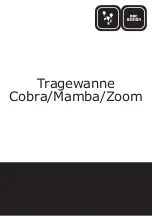
48/94
Siemens Building Technologies
Basic Documentation RVD110, RVD130
CE1P2381E
HVAC Products
14 Function block D.h.w. heating
27.05.2004
•
With pump heating circuits (plant types no. 2 through 7), it can occur that too hot
water reaches the heating circuit. Caution should be exercised particularly in the
case of underfloor heating systems!
A mixing heating circuit (plant type no. 8), by contrast, can lower its flow temperature
through mixing
•
With plant types no. 4 through 6, the space heating circuit and the d.h.w. circuit re-
ceive their heat from separate heat exchangers. Shifting priority acts like parallel pri-
ority; the demand (d.h.w. or maximum selection) is not of any relevance.
Nevertheless, the setting can be made
•
No priority can be selected with plant type no. 3. The diverting valve always ensures
absolute priority
•
If, during charging pump overrun, the heating circuit calls for heat, the heating circuit
pump will be activated,
independent
of the selected priority
14.3.5 Charging
pump
overrun
To avoid the cumulation of heat, charging pump overrun can be selected, depending on
the type of plant. The required overrun time is to be entered on operating line 107. Set-
ting 0 deactivates the function.
•
Plant types no. 2, 6 and 8: Each time d.h.w. heating is terminated, charging pump
Q3 overruns for the period of time entered
•
Plant type no. 3: Each time d.h.w. heating is terminated, diverting valve Y7 maintains
its position for the period of time entered (in that respect, the diverting valve is
treated like the charging pump)
•
Plant type no. 6: Each time d.h.w. is drawn, charging pump Q3 overruns for the pe-
riod of time entered
•
Plant type no. 7: Each time d.h.w. heating is terminated, both charging pump Q3
(primary circuit) and charging pump Q7 (secondary circuit) overrun for the period of
time entered.
With this type of plant, the overrun time of charging pump Q7 can be entered sepa-
rately (operating line 108). It starts only after the overrun time of pump Q3 has
elapsed
With plant types no. 2, 3, 7 and 8, d.h.w. stops its pump overrun when the heating cir-
cuit demands heat from the heat exchanger and the common flow temperature is lower
than the demand.
The overrun function is not affected by the type of priority. Pump overrun can be inter-
rupted by protection against the discharging of d.h.w. or by locking signals initiated by
heat generating equipment or heat consumers.
14.3.6 Frost protection for the d.h.w.
The d.h.w. storage tank is protected against frost. Frost protection for d.h.w. is auto-
matically activated when the d.h.w. temperature (sensor B3 or B71) drops below 5 °C.
The charging pump (diverting valve with plant type no. 3) will be activated and a d.h.w.
temperature of at least 5 °C is maintained. This frost protection is used with both d.h.w.
heating ON (operating mode button
lit) and d.h.w. heating OFF.
No frost protection for the d.h.w. is possible with plant types no. 4 and 5.
If, with plant types no. 6 and 7, a d.h.w. thermostat is used in place of a sensor, no frost
protection for the d.h.w. is possible.
Notes
Caution
Содержание RVD110
Страница 86: ...Siemens Building Technologies Basic Documentation RVD110 RVD130 CE1P2381E HVAC Products Index 27 05 2004 ...
Страница 92: ...92 94 Siemens Building Technologies Basic Documentation RVD110 RVD130 CE1P2381E HVAC Products 27 05 2004 ...
Страница 93: ...93 94 Siemens Building Technologies Basic Documentation RVD110 RVD130 CE1P2381E HVAC Products 27 05 2004 ...
















































